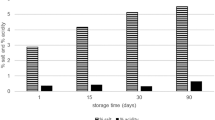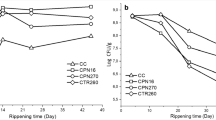Abstract
Lactococcus lactis subsp. lactis NCCB100539 isolated from an artisanal raw ewe’s milk cheese was evaluated as a potential starter culture in white-brined cheese. As a safety criteria, the cytotoxicity of the viable and heat-killed cells and CFE of this strain were determined on Caco-2 cell line by MTT assay. The antibiotic sensitivity of the strain to nine different antibiotics was also investigated. Cheeses produced using this strain were compared with control cheese in terms of physicochemical, microbiological, sensory properties as well as the peptide and volatile profiles during the 90-days of ripening period. Experimental cheeses had more extensive proteolysis as well as higher sensory scores. Incorporated L. lactis also led to an improvement in the microbial cheese quality. Neither living nor the dead cells and CFE of the strain showed cytotoxicity on Caco-2 cells. Therefore, L. lactis NCCB100539 strain could be a good starter candidate for the industrial white-brined cheeses.
Graphical abstract





Similar content being viewed by others
References
Axelsson L. Lactic Acid Bacteria: Classification and physiology. Food Science and Technology. 139: 1-66 (2004)
Bhaskaracharya RK, Shah, NP. Texture characteristics and microstructure of skim milk mozzarella cheeses made using exopolysaccharide or non-exopolysaccharide producing starter cultures. Australian Journal of Dairy Technology. 55: 132-138 (2000)
Bulajić S, Mijačević Z, Ledina T, Golić B. Safety evaluation of Sjenica Cheese with regard to coagulase-positive staphylococci and antibiotic resistance of lactic acid bacteria and Staphylococci. Acta Veterinaria. 65(4): 518–537 (2015)
Cadwallader KR, Singh TK. Flavours and off-flavours in milk and dairy products. Advanced Dairy Chemistry. 14: 631–690 (2009)
Carbonell M, Nunez M, Fernández-Garcia E. Evolution of the volatile components of ewe raw milk La Serena cheese during ripening. Correlation with flavour characteristics. EDP Sciences. 82: 683-698 (2002)
Chimchang J, Theparee T, Wongein S, Trivirot T, Tanasupawa S, Taweechotipatr M, Wongsatayanon B. Screening of potential probiotic lactic acid bacteria with anticancer properties. Journal of the Medical Association of Thailand. 8: 70-78 (2016)
Clark S, Costello M. Dairy products evaluation competitions. The sensory evaluation of dairy products. 43–71 (2009).
Coelho MC, Malcata FX, Silva CCG. Lactic Acid Bacteria in Raw-Milk Cheeses: From Starter Cultures to Probiotic Functions. Foods. 11: 2276. (2022)
Curioni PMG, Bosset JO. Key odorants in various cheese types as determined by gas chromatography-olfactometry. International Dairy Journal. 12: 959-984 (2002)
Delahunty CM, Drake M. Sensory Character of Cheese and its Evaluation. Cheese: Chemistry, Physics and Microbiology. 1: 455-487 (2004)
Dolci P, Ferrocino I, Giordano M, Pramotton R, Vernetti-Prot L, Zenato S, Barmaz A. Impact of Lactococcus lactis as starter culture on microbiota and metabolome profile of an Italian raw milk cheese. International Dairy Journal. 110: 104804 (2020)
Dowdell P, Chankhamhaengdecha S, Panbangred W, Janvilisri T, Arroonual, A. Probiotic Activity of Enterococcus faecium and Lactococcus lactis Isolated from Thai Fermented Sausages and Their Protective Effect Against Clostridium difficile. Probiotics and Antimicrobial Proteins. 12: 641–648 (2020)
Fernandez E, Alegría A, Delgado S, Martín MC, Mayo, B. Comparative phenotypic and molecular genetic profiling of wild Lactococcus lactis subsp. lactis strains of the L. lactis subsp. lactis and L. lactis subsp. cremoris genotypes, isolated from starter-free cheeses made of raw milk. Applied and Environmental Microbiology. 77: 5324-5335 (2011)
Fox PF, Guinee TP, Cogan TM, McSweeney PLH. Fundamentals of Cheese Science. ISBN 978-1-4899-7681-9 (2017)
Fraqueza MJ. Antibiotic resistance of lactic acid bacteria isolated from dry fermented sausages. International Journal of Food Microbiology. 212: 76-88 (2015)
Guinee TP Salting and the role of salt in cheese. International Journal of Dairy Technology. 57(2-3): 99-109 (2004)
Harrigan WF, McCance ME. Laboratory methods in food and dairy microbiology. London. ISBN: 0-12-326043-4 (1976)
Kimoto-Nira H, Aoki R, Sasaki K, Suzuki C, Mizumachi K. Oral intake of heat-killed cells of Lactococcus lactis strain H61 promotes skin health in women. Journal of Nutritional Science. 6: 1-18 (2012)
Kuchroo CN, Fox PF. Fractionation of the water-soluble nitrogen from cheddar cheese- Chemical methods. Milchwissenschaft-Milk Science International, 37(11): 651-653 (1982)
Law BA. Proteolysis in relation to normal and accelerated cheese ripening. Cheese; chemistry, physics and microbiology. Elsevier Applied Science. 365–392 (1987)
Le Bars D, Yvon M. Formation of diacetyl and acetoin by Lactococcus lactis via aspartate catabolism. Journal of Applied Microbiology. 104: 171–177 (2008).
Lozo J, Topisirovic L, Kojic M. Natural bacterial isolates as an inexhaustible source of new bacteriocins. Applied Microbiology and Biotechnology. 105(2): 477-492 (2021)
Malesevic M, Stanisavljevic N, Miljkovic M, Jovcic B, Filipic B, Studholme DJ, Kojic M. The large plasmidome of Lactococcus lactis subsp. lactis bv. diacetylactis S50 confers its biotechnological properties. International Journal of Food Microbiology. 16: 337:108935 (2021)
McSweeney P. Biochemistry of cheese ripening. International Journal of Dairy Technology. 57 (2-3): 147-155 (2004)
McSweeney PLH, Sousa MJ. Biochemical pathways for the production of flavour compounds in cheeses during ripening: A review. EDP Sciences. 80: 293–324 (2000)
Messaoudi S, Madi A, Prévost H, Feuilloley M, Manai M, Dousset X, Connil N. In vitro evaluation of the probiotic potential of Lactobacillus salivarius SMXD51. Anaerobe. 18(6): 584–589 (2012)
Mokoena MP. Lactic Acid Bacteria and Their Bacteriocins: Classification, Biosynthesis and Applications against Uropathogens: A Mini-Review. Molecules. 22: 1255 (2017)
National Committee for Clinical Laboratory Standards (NCCLS). Performance standards for antimicrobial susceptibility testing; Twenty second informational supplement. M100-S22, 32,3 (2012)
Ozturkoglu-Budak S, Figge MJ, Houbraken ., de Vries RP. The diversity and evolution of microbiota in traditional Turkish divle cave cheese during ripening. International Dairy Journal. 58: 50-53 (2016a)
Ozturkoglu-Budak S, Gursoy A, Aykas DP, Kocak C, Donmez S, de Vries RP, Bron PA. Volatile compound profiling of Turkish Divle Cave cheese during production and ripening. Journal of Dairy Science. 99(7): 5120-5131 (2016b)
Ozturkoglu-Budak S, Wiebenga A, Bron P, Vries R. Protease and lipase activities of fungal and bacterial strains derived from an artisanal raw ewe's milk cheese. International Journal of Food Microbiology. 237: 17–27 (2016c)
Pytka M, Kordowska-Wiater M, Wajs J, Glibowski P, Sajnaga E. Usefulness of Potentially Probiotic L. lactis Isolates from Polish Fermented Cow Milk for the Production of Cottage Cheese. Applied Sciences. 12(23): 12088 (2022)
Qian MC, Burbank HM. Hard Italian cheeses: Parmigiano- Reggiano and Grana Padano in Improving the Flavour of Cheese. Cambridge: Woodhead, p 421–443 (2007)
Ramírez-Nunez J, Romero-Medrano R, Nevarez-Moorillon GV, Gutierrez-Mendez N. Effect of pH and salt gradient on the autolysis of Lactococcus lactis strains. Brazilian Journal of Microbiology. 42: 1495-1499 (2011)
Reyes-Díaz R, González-Córdova AF, Estrada-Montoya MC, Méndez-Romero JI, Mazorra-Manzano M., Soto-Valdez H, Vallejo-Cordoba B. Volatile and sensory evaluation of Mexican Fresco cheese as affected by specific wild Lactococcus lactis strains. Journal of Dairy Science. 103, 242–253 (2020)
Smit G, Smit BA, Engels WJM. Flavour formation by lactic acid bacteria and biochemical flavour profiling of cheese products. FEMS Microbiology Reviews. 29: 591-610 (2005)
Soares Pinto M, Fernández de Carvalho A, Dos Santos Pires A, de Paula J, Sobral D, Resplande Magalhães F. Survival of Listeria innocua in Minas traditional Serro cheese during ripening. Food Control. 20(12): 1167-1170 (2009)
Thokchom S, Joshi SR. Antibiotic resistance and probiotic properties of dominant lactic microflora from Tungrymbai, an ethnic fermented soybean food of India. Journal of Microbiology. 50: 535–539 (2012)
Topisirovic L, Kojic M, Fira D, Golic N, Strahinic I, Lozo J. Potential of lactic acid bacteria isolated from specific natural niches in food production and preservation. International Journal of Microbiology. 112(3): 230-5 (2006)
Wilkins TD, Holdeman LV, Abramson IJ, Moore WEC. (Standardized single-disc method for antibiotic susceptibility testing of anaerobic bacteria. Antimicrobial Agents Chemotheraphy. 1: 451-459 (1972)
Acknowledgements
The authors are grateful to the Dairy Plant of Ankara University, Ankara, Turkey, for facilitating and providing equipment for this work. The authors state that they did not receive any funding for this work.
Author information
Authors and Affiliations
Corresponding author
Ethics declarations
Conflict of interest
The authors declare no conflict of interest.
Additional information
Publisher's Note
Springer Nature remains neutral with regard to jurisdictional claims in published maps and institutional affiliations.
Supplementary Information
Below is the link to the electronic supplementary material.
Rights and permissions
Springer Nature or its licensor (e.g. a society or other partner) holds exclusive rights to this article under a publishing agreement with the author(s) or other rightsholder(s); author self-archiving of the accepted manuscript version of this article is solely governed by the terms of such publishing agreement and applicable law.
About this article
Cite this article
Altin, C., Kabwanga, T.I., Kiran, F. et al. Evaluation of autochthonous Lactococcus lactis subsp. lactis strain as a candidate starter culture in white-brined cheese. Food Sci Biotechnol 33, 115–127 (2024). https://doi.org/10.1007/s10068-023-01332-y
Received:
Revised:
Accepted:
Published:
Issue Date:
DOI: https://doi.org/10.1007/s10068-023-01332-y




